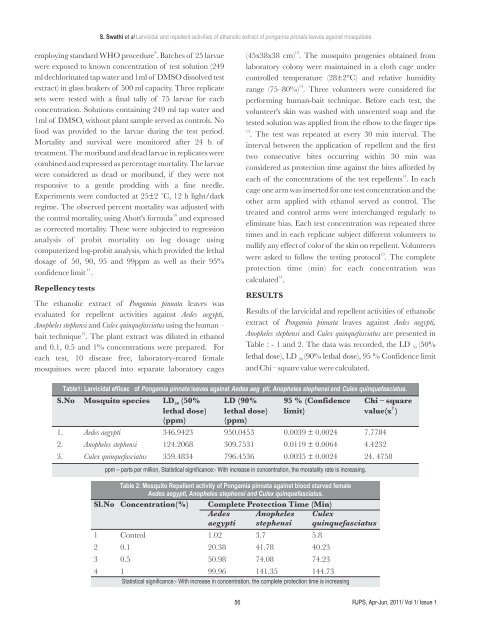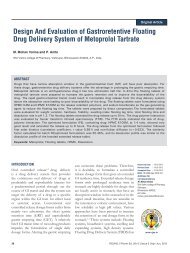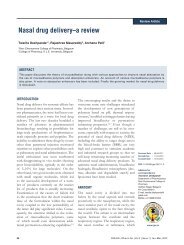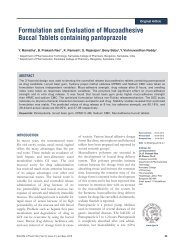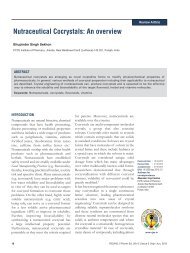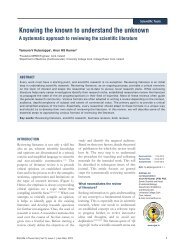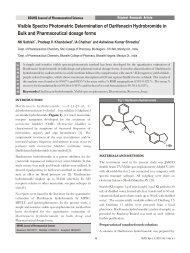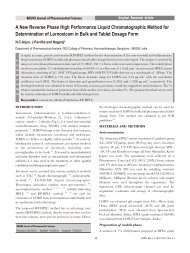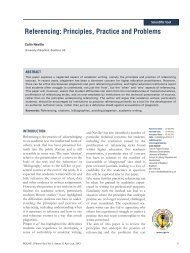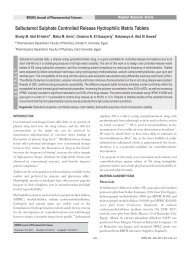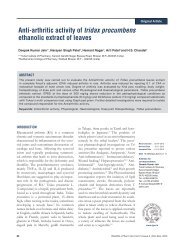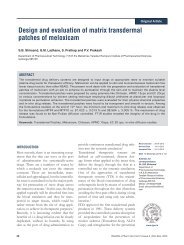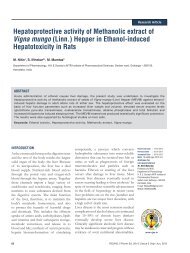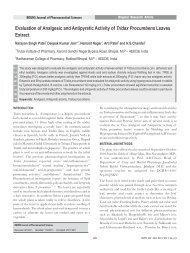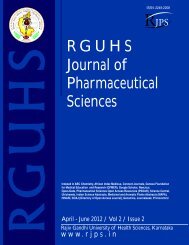final .cdr
final .cdr
final .cdr
You also want an ePaper? Increase the reach of your titles
YUMPU automatically turns print PDFs into web optimized ePapers that Google loves.
9<br />
employing standard WHO procedure . Batches of 25 larvae<br />
were exposed to known concentration of test solution (249<br />
ml dechlorinated tap water and 1ml of DMSO dissolved test<br />
extract) in glass beakers of 500 ml capacity. Three replicate<br />
sets were tested with a <strong>final</strong> tally of 75 larvae for each<br />
concentration. Solutions containing 249 ml tap water and<br />
1ml of DMSO, without plant sample served as controls. No<br />
food was provided to the larvae during the test period.<br />
Mortality and survival were monitored after 24 h of<br />
treatment. The moribund and dead larvae in replicates were<br />
combined and expressed as percentage mortality. The larvae<br />
were considered as dead or moribund, if they were not<br />
responsive to a gentle prodding with a fine needle.<br />
Experiments were conducted at 25±2 ˚C, 12 h light/dark<br />
regime. The observed percent mortality was adjusted with<br />
10<br />
the control mortality, using Abott's formula and expressed<br />
as corrected mortality. These were subjected to regression<br />
analysis of probit mortality on log dosage using<br />
computerized log-probit analysis, which provided the lethal<br />
dosage of 50, 90, 95 and 99ppm as well as their 95%<br />
11<br />
confidence limit .<br />
Repellency tests<br />
S. Swathi et al Larvicidal and repellent activities of ethanolic extract of pongamia pinnata leaves against mosquitoes<br />
The ethanolic extract of Pongamia pinnata leaves was<br />
evaluated for repellent activities against Aedes aegypti,<br />
Anopheles stephensi and Culex quinquefasciatus using the human –<br />
12<br />
bait technique . The plant extract was diluted in ethanol<br />
and 0.1, 0.5 and 1% concentrations were prepared. For<br />
each test, 10 disease free, laboratory-reared female<br />
mosquitoes were placed into separate laboratory cages<br />
13<br />
(45x38x38 cm) . The mosquito progenies obtained from<br />
laboratory colony were maintained in a cloth cage under<br />
controlled temperature (28±2°C) and relative humidity<br />
14<br />
range (75–80%) . Three volunteers were considered for<br />
performing human-bait technique. Before each test, the<br />
volunteer's skin was washed with unscented soap and the<br />
tested solution was applied from the elbow to the finger tips<br />
13<br />
. The test was repeated at every 30 min interval. The<br />
interval between the application of repellent and the first<br />
two consecutive bites occurring within 30 min was<br />
considered as protection time against the bites afforded by<br />
14<br />
each of the concentrations of the test repellents . In each<br />
cage one arm was inserted for one test concentration and the<br />
other arm applied with ethanol served as control. The<br />
treated and control arms were interchanged regularly to<br />
eliminate bias. Each test concentration was repeated three<br />
times and in each replicate subject different volunteers to<br />
nullify any effect of color of the skin on repellent. Volunteers<br />
13<br />
were asked to follow the testing protocol . The complete<br />
protection time (min) for each concentration was<br />
14<br />
calculated .<br />
RESULTS<br />
Results of the larvicidal and repellent activities of ethanolic<br />
extract of Pongamia pinnata leaves against Aedes aegypti,<br />
Anopheles stephensi and Culex quinquefasciatus are presented in<br />
Table : - 1 and 2. The data was recorded, the LD 50 (50%<br />
lethal dose) , LD 90 (90% lethal dose) , 95 % Confidence limit<br />
and Chi – square value were calculated.<br />
Table1: Larvicidal efficacy of Pongamia pinnata leaves against Aedes aegypti, Anopheles stephensi and Culex quinquefasciatus.<br />
S.No Mosquito species LD (50% LD (90% 95 % (Confidence Chi – square<br />
50<br />
2<br />
lethal dose) lethal dose) limit) value(x )<br />
(ppm) (ppm)<br />
1. Aedes aegypti 346.9423 950.0453 0.0039 ± 0.0024 7.7784<br />
2. Anopheles stephensi 124.2068 309.7531 0.0119 ± 0.0064 4.4232<br />
3. Culex quinquefasciatus 359.4834 796.4536 0.0035 ± 0.0024 24. 4758<br />
ppm – parts per million, Statistical significance:- With increase in concentration, the moratality rate is increasing.<br />
Table 2: Mosquito Repellent activity of Pongamia pinnata against blood starved female<br />
Aedes aegypti, Anopheles stephensi and Culex quinquefasciatus.<br />
Sl.No Concentration(%) Complete Protection Time (Min)<br />
Aedes Anopheles Culex<br />
aegypti stephensi quinquefasciatus<br />
1 Control 1.02 3.7 5.8<br />
2 0.1 20.38 41.78 40.23<br />
3 0.5 50.98 74.08 74.23<br />
4 1 99.96 141.35 144.73<br />
Statistical significance:- With increase in concentration, the complete protection time is increasing<br />
56<br />
RJPS, Apr-Jun, 2011/ Vol 1/ Issue 1


